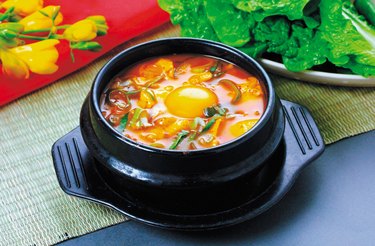
A soup and salad diet can help you lose weight without severely restricting food and caloric intake. The high water and fiber content in soups and veggie-rich salads fills you up to prevent hunger cravings that lead to overeating. Fill your soups and salads with a variety of nutrient-rich, low-calorie foods including vegetables, lean meats, fish and legumes. Eat three meals per day to keep blood sugar levels steady and energy levels high.
Stick to the Serving Size
Video of the Day
Preparing homemade soups and salads means you control both the ingredients and the portions. This ensures you are eating nutritious meals that benefit your health and won't exceed your daily caloric, fat or sodium intakes. The standard serving size for a side salad is 3 ounces, while an entree salad is approximately 8 ounces. Soup serving sizes are approximately 6 ounces. Stick to these sizes for each of your soup and salad meals.
Video of the Day
Super Soups
Make your own soups at home with broths, veggies and, if you eat them, lean meats. Cook a variety of vegetables including carrots, peas, broccoli and asparagus. Veggies are low in calories, have no added sugars and little to no fat, and are a rich source of vitamins and minerals for optimum health. They should form the foundation of your soup and salad diet. Prepare soup bowls with half to two-thirds veggies and the remaining half to one-quarter with meats and/or grains.
Size-Shrinking Salads
Salads are a convenient way to eat nutrient-rich vegetables, lean proteins and healthy fats in moderation. Protein is essential for muscle growth and also stabilizes blood sugar levels to prevent cravings that lead to overeating. Healthy fats are good for the hair, skin and nails and also have a satiating effect on the appetite. Use leafy greens such as Swiss chard or kale as your base, then add in chopped bell peppers, cucumbers, tomatoes and sweet potatoes. Drizzle with a salad dressing made of olive oil, vinegar and a little mustard or herbs for extra spice.
Watch the Salt
Watch your salt intake while on a soup and salad diet. Canned soups tend to be particularly high in sodium, with a 1-cup serving of chicken noodle soup dishing up 840 milligrams of salt. Excess sodium in the diet can lead to hypertension as well as uncomfortable bloating and weight gain from fluid retention. The American Heart Association recommends eating less than 1,500 milligrams of sodium per day. Check the labels of store-bought salad dressings as well for sodium as they can pack anywhere between 300 and 500 milligrams of sodium in a 2-tablespoon serving. Make your own salad dressings at home to control the amount of salt you eat.